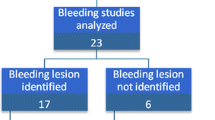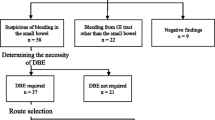Abstract
Objective
To retrospectively compare the diagnostic capabilities of 64-section CT enteroclysis with those of video capsule endoscopy (VCE) to elucidate the cause of obscure gastrointestinal bleeding.
Methods
Thirty-two patients who had 64-section CT enteroclysis and VCE because of obscure gastrointestinal bleeding were included. Imaging findings were compared with those obtained at double balloon endoscopy, surgery and histopathological analysis, which were used as a standard of reference.
Results
Concordant findings were found in 22 patients (22/32; 69%), including normal findings (n = 13), tumours (n = 7), lymphangiectasia (n = 1) and inflammation (n = 1), and discrepancies in 10 patients (10/32; 31%), including ulcers (n = 3), angioectasias (n = 2), tumours (n = 2) and normal findings (n = 3). No statistical difference in the proportions of abnormal findings between 64-section CT enteroclysis (11/32; 34%) and VCE (17/32, 53%) (P = 0.207) was found. However, 64-section CT enteroclysis helped identify tumours not detected at VCE (n = 2) and definitely excluded suspected tumours (n = 3) because of bulges at VCE. Conversely, VCE showed ulcers (n = 3) and angioectasias (n = 2) which were not visible at 64-section CT enteroclysis.
Conclusion
Our results suggest that 64-section CT enteroclysis and VCE have similar overall diagnostic yields in patients with obscure gastrointestinal bleeding. However, the two techniques are complementary in this specific population.





Similar content being viewed by others
References
Lewis BS (1994) Small intestinal bleeding. Gastroenterol Clin North Am 23:67–91
Pennazio M, Arrigoni A, Risio M, Spandre M, Rossini FP (1995) Clinical evaluation of push-type enteroscopy. Endoscopy 27:164–170
Maglinte DD, Sandrasegaran K, Chiorean M, Dewitt J, McHenry L, Lappas JC (2007) Radiologic investigations complement and add diagnostic information to capsule endoscopy of small-bowel diseases. AJR Am J Roentgenol 189:306–312
Friedman S (2004) Comparison of capsule endoscopy to other modalities in small bowel. Gastrointest Endosc Clin N Am 14:51–60
Maglinte DT (2005) Capsule imaging and the role of radiology in the investigation of diseases of the small bowel. Radiology 236:763–767
Iddan G, Meron G, Glukhovsky A, Swain P (2000) Wireless capsule endoscopy. Nature 405:417
Lewis BS, Swain P (2002) Capsule endoscopy in the evaluation of patients with suspected small intestinal bleeding: results of a pilot study. Gastrointest Endosc 56:349–353
Estevez E, Gonzalez-Conde B, Vazquez-Iglesias JL et al (2006) Diagnostic yield and clinical outcomes after capsule endoscopy in 100 consecutive patients with obscure gastrointestinal bleeding. Eur J Gastroenterol Hepatol 18:881–888
Fireman Z, Friedman S (2004) Diagnostic yield of capsule endoscopy in obscure gastrointestinal bleeding. Digestion 70:201–206
Raju GS, Gerson L, Das A, Lewis B, Association AG (2007) American Gastroenterological Association (AGA) Institute medical position statement on obscure gastrointestinal bleeding. Gastroenterology 133:1694–1696
Lewis BS, Eisen GM, Friedman S (2005) A pooled analysis to evaluate results of capsule endoscopy trials. Endoscopy 37:960–965
Baichi MM, Arifuddin RM, Mantry PS (2007) Small-bowel masses found and missed on capsule endoscopy for obscure bleeding. Scand J Gastroenterol 42:1127–1132
Ponsaing LG, Kiss K, Loft A, Jensen LI, Hansen MB (2007) Diagnostic procedures for submucosal tumors in the gastrointestinal tract. World J Gastroenterol 13:3301–3310
Filippone A, Cianci R, Milano A, Valeriano S, Di Mizio V, Storto ML (2008) Obscure gastrointestinal bleeding and small bowel pathology: comparison between wireless capsule endoscopy and multidetector-row CT enteroclysis. Abdom Imaging 33:398–406
Boriskin HS, Devito BS, Hines JJ, Scarmato VJ, Friedman B (2009) CT enterography vs. capsule endoscopy. Abdom Imaging 34:149–155
Hara AK, Leighton JA, Sharma VK, Fleischer DE (2004) Small bowel: preliminary comparison of capsule endoscopy with barium study and CT. Radiology 230:260–265
Rajesh A, Sandrasegaran K, Jennings SG, Maglinte DDT, McHenry L, Lappas JC et al (2009) Comparison of capsule endoscopy with enteroclysis in the investigation of small bowel disease. Abdom Imaging 34:459–466
Zhang BL, Jiang LL, Chen CX, Zhong BS, Li YM (2010) Diagnosis of obscure gastrointestinal hemorrhage with capsule endoscopy in combination with multiple-detector computed tomography. J Gastroenterol Hepatol 25:75–79
Romano S, De Lutio E, Rollandi GA, Romano L, Grassi R, Maglinte DD (2005) Multidetector computed tomography enteroclysis (MDCT-E) with neutral enteral and IV contrast enhancement in tumor detection. Eur Radiol 15:1178–1183
Kohli MD, Maglinte DD (2009) CT enteroclysis in small bowel Crohn’s disease. Eur J Radiol 69:398–403
Boudiaf M, Jaff A, Soyer P, Bouhnik Y, Hamzi L, Rymer R (2004) Small bowel diseases: prospective evaluation of multidetector row helical CT enteroclysis in 107 consecutive patients. Radiology 203:338–344
Pilleul F, Penigaud M, Milot L, Saurin JC, Chayvialle JA, Valette PJ (2006) Possible small-bowel neoplasms: contrast-enhanced and water-enhanced multidetector CT enteroclysis. Radiology 241:796–801
Rydberg J, Liang Y, Teague SD (2003) Fundamentals of multichannel CT. Radiol Clin North Am 41:465–474
Huprich JE, Fletcher JG, Alexander JA, Fidler JL, Burton SS, McCullough CH (2008) Obscure gastrointestinal bleeding: evaluation with 64-section multiphase CT enterography—initial experience. Radiology 246:562–571
Voderholzer WA, Ortner M, Rogalla P, Beinhölzl J, Lochs H (2003) Diagnostic yield of wireless capsule enteroscopy in comparison with computed tomography enteroclysis. Endoscopy 35:1009–1014
Kamaoui I, De-Luca V, Ficarelli S, Mennesson N, Lombard-Bohas C, Pilleul F (2010) Value of CT enteroclysis in suspected small-bowel carcinoid tumors. AJR Am J Roentgenol 194:629–633
Tang SJ, Christodoulou D, Zanati S, Dubcenco E, Petroniene R, Cirocco M et al (2004) Wireless capsule endoscopy for obscure gastrointestinal bleeding: a single-centre, one-year experience. Can J Gastroenterol 18:559–565
Moch A, Herlinger H, Kochman ML, Levine MS, Rubesin SE, Laufer I (1994) Enteroclysis in the evaluation of obscure gastrointestinal bleeding. AJR Am J Roentgenol 163:1381–1384
Rabe FE, Becker GJ, Besozzi MJ, Miller RE (1981) Efficacy study of the small bowel examination. Radiology 140:47–50
Carey EJ, Leighton JA, Heigh RI, Shiff AD, Sharma VK, Post JK et al (2007) A single-center experience of 260 consecutive patients undergoing capsule endoscopy for obscure gastrointestinal bleeding. Am J Gastroenterol 102:89–95
Bensimhon D, Soyer P, Boudiaf M, Fargeaudou Y, Nemeth J, Pocard M et al (2009) Imaging of gastrointestinal stromal tumors. J Radiol 90:469–480
Van Weyenberg SJB, Meijerink MR, Jacobs MA, Van der Peet DL, Van Kuijk C, Mulder CJ et al (2010) MR enteroclysis in the diagnosis of small-bowel neoplasms. Radiology 254:765–773
Masselli G, Polettini E, Casciani E, Bertini L, Vecchioli A, Gualdi G (2009) Small-bowel neoplasms: prospective evaluation of MR enteroclysis. Radiology 251:743–750
Pennazio M, Rondonotti E, de Franchis R (2008) Capsule endoscopy in neoplastic diseases. World J Gastroenterol 14:5245–5253
Muñoz-Navas M (2009) Capsule endoscopy. World J Gastroenterol 15:1584–1586
Cobrin GM, Pittman RH, Lewis BS (2006) Increased diagnostic yield of small bowel tumors with capsule endoscopy. Cancer 107:22–27
Waterman M, Eliakim R (2009) Capsule enteroscopy of the small intestine. Abdom Imaging 34:452–458
Author information
Authors and Affiliations
Corresponding author
Rights and permissions
About this article
Cite this article
Khalife, S., Soyer, P., Alatawi, A. et al. Obscure gastrointestinal bleeding: preliminary comparison of 64-section CT enteroclysis with video capsule endoscopy. Eur Radiol 21, 79–86 (2011). https://doi.org/10.1007/s00330-010-1896-2
Received:
Revised:
Accepted:
Published:
Issue Date:
DOI: https://doi.org/10.1007/s00330-010-1896-2




